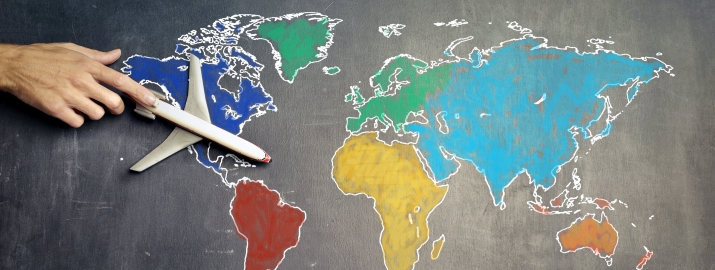
Europe Countries
Table of Contents
Despite being the second smallest continent in the world, Europe has hosted many civilizations. Located in the east of the Atlantic Ocean, in the north of Africa, and in the west of Asia, Europe is in the form of a peninsula. In addition, Europe is also referred to as Eurasia due to its connection with the Asian continent. The Ural Mountains in the east, the Atlantic Ocean in the west and north, and the Mediterranean Sea in the south define the borders of Europe. In short, Europe is located on an area of 10,523,000 km².
There are 45 countries on this peninsula-shaped continent. In this article, we will take a closer look at countries in Europe, their capitals, and their subregions. Stay tuned to learn more about Europe!
How Many Countries Are There in Europe?
There are currently 45 countries in Europe. In the table below, you can see the entire list of Europe countries with geographic regions and capitals.
Country | Capital | Subregion |
Belarus | Minsk | Eastern Europe |
Bulgaria | Sofia | Eastern Europe |
Czech Republic | Prague | Eastern Europe |
Hungary | Budapest | Eastern Europe |
Moldova | Chisinau | Eastern Europe |
Poland | Warsaw | Eastern Europe |
Romania | Bucharest | Eastern Europe |
Russian Federation | Moscow | Eastern Europe |
Slovakia | Bratislava | Eastern Europe |
Ukraine | Kiev | Eastern Europe |
Austria | Vienna | Western Europe |
Belgium | Brussels | Western Europe |
France | Paris | Western Europe |
Germany | Berlin | Western Europe |
Liechtenstein | Vaduz | Western Europe |
Luxembourg | Luxembourg | Western Europe |
Netherlands | Amsterdam | Western Europe |
Switzerland | Bern | Western Europe |
Denmark | Copenhagen | Northern Europe |
Estonia | Tallinn | Northern Europe |
Finland | Helsinki | Northern Europe |
Iceland | Reykjavik | Northern Europe |
Ireland | Dublin | Northern Europe |
Latvia | Riga | Northern Europe |
Lithuania | Vilnius | Northern Europe |
Norway | Oslo | Northern Europe |
Sweden | Stockholm | Northern Europe |
United Kingdom | London | Northern Europe |
Albania | Tirana | Southern Europe |
Andorra | Andorra la Vella | Southern Europe |
Bosnia and Herzegovina | Sarajevo | Southern Europe |
Croatia | Zagreb | Southern Europe |
Greece | Athens | Southern Europe |
Vatican City | Vatican City | Southern Europe |
Italy | Rome | Southern Europe |
Kosovo | Pristina | Southern Europe |
North Macedonia | Skopje | Southern Europe |
Malta | Valletta | Southern Europe |
Montenegro | Podgorica | Southern Europe |
Portugal | Lisbon | Southern Europe |
San Marino | San Marino | Southern Europe |
Serbia | Belgrade | Southern Europe |
Slovenia | Ljubljana | Southern Europe |
Spain | Madrid | Southern Europe |
Several countries are not included in the list of Europe countries above. Let’s see why these countries are not included:
- The Faroe Islands are an island group between the North Atlantic Ocean and the Norwegian Sea and are an autonomous country as part of the Kingdom of Denmark.
- Although Greenland is geographically located in North America, it is an autonomous territory of Denmark.
- All of Turkey’s lands in Europe consist only of Eastern Thrace.
- Cyprus, an island in the Eastern Mediterranean, is part of the Middle East.
- Western Kazakhstan is partly in Europe and partly in Asia.
European Regions
There are four subregions or geographical regions in Europe.
- Eastern Europe
- Western Europe
- Northern Europe
- Southern Europe
Eastern Europe
Conventionally, the part of the European continent between the Asian mainland and Western Europe is Eastern Europe. In other words, it is the region between the west of the Ural Mountains and the east of Germany.
The definition of Eastern Europe refers to the geopolitical unity of the Eastern bloc countries during the Cold War period.
According to the current data, its population has exceeded 292 million.
Western Europe
It is a region located in the western part of the European continent. Western Europe is surrounded by Spain and the Mediterranean Sea to the south, the English Channel to the north, Italy, Switzerland, and Germany to the east, and the Atlantic Ocean to the west.
According to the current data, its population is around 197 million.
Northern Europe
Northern Europe is north of the Baltic Sea, the English Channel, and Western Europe. The region also includes the Baltic countries Latvia, Estonia, and Lithuania. They were part of the Soviet Union until the Baltic states declared independence in 1989.
According to the current data, its population is more than 107 million.
Southern Europe
Southern Europe, also known as Mediterranean Europe, refers to the southern part of the European continent. Many countries in Southern Europe border the Mediterranean.
According to the current data, its current population is more than 151 million.
Related Articles
Europe Countries Area
European countries are on a continent established on an area of 10.2 million km². Europe has a 20% larger area than the United States. Also, the area of the European Union is 4.23 million km².
The Population of the Countries in Europe
The total population of Europe is an estimated 743 million. The most populated country in the list of European countries is Russia. About 110 million people live in the European part of Russia. Germany, with nearly 83 million citizens, and France, with a population of around 67 million, follows Russia. Close to 67 million people live in the UK.
More About Countries in Europe
Geographical Regions of Europe
The geographical regions of Europe are as follows:
- The North Sea
- Scandinavia and the Scandinavian Peninsula
- Baltic Sea
- Great European Plain
- The British Isles
- Central European Highlands
- The Mediterranean
- The Alps
- The Italian Peninsula and the Apennine Mountains
- The Iberian Peninsula
- The Pyrenees
- Balkan Peninsula and the Balkans
- The Caucasus
- The Black Sea
Europe’s Highest Point
Depending on the definition of the inner Eurasian border, if the Caucasus is accepted as the border of Europe, Mount Elbrus is the highest point in Europe. The height of Mount Elbrus, which is the highest point in Russia and the Caucasus, is 5,642 meters.
Mont Blanc is the highest point in Western Europe and the Alps. The height of Mont Blanc, which is included on the UNESCO World Heritage List, is 4808 meters.
Europe's Longest River
The Volga River is the longest in Europe with a length of 3,530 km. Most of the catchment area of the Volga River is within Russia. The Volga River flows into the Caspian Sea.
The Danube is the second-longest river in Europe. The 2,850 km long Danube flows through 10 European Union countries and empties into the Black Sea.
Europe’s Longest Lake
The area of Lake Ladoga, which is the largest lake in Europe, is 17,700 km². There are 660 islands in Lagoda, the 15th largest lake in the world.
The second-largest freshwater lake in Europe is Lake Onega, with an area of 9,800 km².
The third-largest lake in the European continent is Lake Vänern in Western Europe. Vänern has an area of 5,650 km².
The largest lake in Central Europe is Lake Balaton, with an area of 592 km² in Hungary.
Languages Spoken in Countries in Europe
European Union countries have officially recognized 24 languages spoken in Europe.
- Bulgarian
- Dutch
- French
- Irish
- Maltese
- Slovak
- Croatian
- English
- German
- Italian
- Polish
- Slovenian
- Czech
- Estonian
- Greek
- Latvian
- Portuguese
- Spanish
- Danish
- Finnish
- Hungarian
- Lithuanian
- Romanian
- Swedish
Europe Countries: The Bottom Line
There you have it. An introduction to Europe countries. In this article, we have included a lot of information from Europe’s highest point Mount Elbrus to its longest river, the Volga. I hope this guide will inspire you to learn more about Europe!
Frequently Asked Questions About Europe Countries
How many countries are there in Europe?
There are 45 countries in Europe. Turkey, Cyprus, and West Kazakhstan are not included in this list due to their geographical location. In addition, the Faroe Islands and Greenland are not included in the list of Europe countries, as they belong to the Kingdom of Denmark. Moreover, the territory of the EU is mainly in Europe.
How many subregions are there in Europe?
There are four sub-regions or geographical regions in the European continent. These are Eastern Europe, Western Europe, Northern Europe, and Southern Europe.
Which is the most populated country in Europe?
The most populated country in Europe is Russia, located in Eastern Europe. A total of 144 million people live in Russia. The density of the European side of Russia is around 110 million.
How many geographical regions are there in Europe?
There are 14 geographical regions in Europe. These are The North Sea, Scandinavia, and the Scandinavian Peninsula, Baltic Sea, Great European Plain, The British Isles, Central European Highlands, Mediterranean, The Alps, The Italian Peninsula and the Apennine Mountains, The Iberian Peninsula, The Pyrenees, Balkan Peninsula, and the Balkans, Caucasus, and The Black Sea.
Are all European countries developed?
While the majority of European governments have highly developed economies and GDP per capita that exceeds the global average, several European economies are nevertheless less prosperous than the rest of the world on the basis of the Human Development Index.
What European country should I visit first?
This depends on your preferences and tastes. If you’re a history buff, you can start with Italy. If you want to enjoy the sun and beach, you can consider visiting Spain or Greece. France is another popular tourist destination in Europe thanks to its famous landmarks.
If you want to explore Nordic culture, you can start with the Scandinavian countries. The United Kingdom is also a great choice if you’re fond of landscapes.

